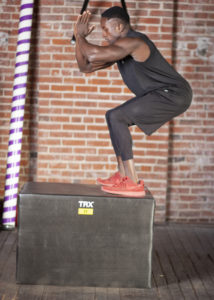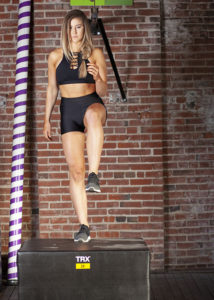
Plyometrics have become an increasingly popular training option in recent years. It’s hard to find gym that doesn’t have a few boxes for people to jump on top of.
While it may look like a way to have fun in the gym, plyometrics are serious exercises, based on a fair amount of science with a very specific goal: to improve your power.
Despite what it may look like, there’s more to plyometrics than just jumping up, down, and around the gym. True plyometric exercises have some very specific requirements. And you’ll need to be more mindful of rest and recovery in order to get the best benefits.
Plyometrics, performed correctly, could significantly increase your power output. More importantly, plyometrics could be the key to improving your boxing footwork.
Read on to find out more about how it works, how it affects your boxing footwork, and some key exercises you’ll want to incorporate into your training.
What are Plyometrics
Originally designed to improve the performance of sprinters, plyometrics have become a common training tool for almost every sport. The goal of plyometric exercises is to develop explosive power in the targeted muscle groups.
In the case of plyometrics, “power” means the exerting as much force as possible over the shortest possible time. Therefore, plyometric exercises are characterized by quick explosive movements. A typical exercise is made of three phases: lengthen, load, and fire.

- Lengthen: In this phase, your muscles stretch out, lengthening in their effort absorb impact and slow you down. For example, as you land from a jump and sink into a squat position, several muscle groups in your legs lengthen to absorb the impact energy. Think of it like a rubber band being stretched out.
- Load: This is that moment of transition, that fraction of second, when your muscles stop getting longer and prepare to contract again. To get the maximum benefit, this moment needs to feel like it takes no time at all. So when you sink into your squat, you don’t rest a moment before jumping again, you jump immediately. This trains your body to transfer all of the impact energy you absorbed back out into an explosive movement.
- Fire: The moment that your muscles contract, quickly and explosively, moving your body in a new direction. When done correctly, your body isn’t just applying the force generated by your muscular strength, but also the stored energy from the lengthen phase. This allows you to exert more power than you could using your muscles alone.
One thing to remember is that Plyometrics don’t replace basic strength training. You still need to build your muscles using the traditional methods. Slow controlled movements working against resistance (free weights, gravity, resistance bands, etc.) build strength. Plyometrics then trains your body to better deliver that strength in one, one controlled burst, over and over again.
How Can I use Plyometrics to Improve my Boxing Footwork?
So now that we understand the basics of plyometric exercises, let’s look at how they help improve your boxing footwork.
- Power for your Punch: As we’ve discussed before, punching power begins in the feet and legs. Plyometric exercises hone your ability to explode from your plant foot through the rest of your body and transfer all that energy into your punch. More power from your legs equals more powerful punches.
- Direction Changes: Footwork is about reacting to what’s happening in the ring. You want to be able to quickly move yourself out of danger or into an advantageous position. The fundamentals of plyometrics focus on heightening your body’s ability to halt your movement and quickly push yourself off into a new direction. Quick, powerful steps mean mean that you won’t be where your opponent expects.
What Plyometric Exercises Should I Be Doing?
The following plyometric exercises should help improve your footwork in the ring.
Box Jumps
These exercises are as simple as the name implies. You jump from the floor up to the top of a box, and then jump back down. The boxes come in a lot varieties, from basic wooden boxes, to boxes wrapped in foam and a non-slip material. The top of the box should be about 18” off the ground. Any higher than that, and you’re really just training your vertical leap, rather than your explosive output.

Box Toe Touches
Box Toe Touches help you train to move from one foot to another quickly. To perform one, stand a few inches in front of a plyo box. Hop into the air, land with one foot touching the top of the box and the other on the ground. Jump again and switch feet. Continue to do this, rapidly switching feet with each hop.
Depth Jumps
Depth jumps are the original plyometric exercise. They are still one of the most challenging and valuable for training powerful legs. Start on top of a box or step that is only 12-15” off the ground, with your toes at or slightly over the edge. Step forward off the platform, drop to the ground into a full squat, then immediately jump up as high as you can into the air.
Explosive Step Ups
The explosive step up will provide the kind of power you need when pushing off of your plant foot into a punch. Stand with feet about shoulder width apart on top of a box or platform that’s about knee height. Step your right foot down to the floor. When your foot makes contact with the floor, quickly push up through your left hip, fully extending your left leg, pulling your right knee up as high as possible. Place both feet on top of the box, step down with your left foot, then quickly push up through your right leg, raising your left knee up toward your chest. Return to a position with both feet on top of the box. Repeat.
Lateral Jumps
Lateral jumps, sometimes called speed skaters, help develop your ability to quickly and powerfully transition between your feet. Bend your knees, push off of your right foot, and jump to your left. Land on your left foot, bringing your right foot behind you, then immediately jump off your left foot to the right. Jump back and forth, speeding up your movements and widening your jumps as you become more comfortable with the movement.
Long Jump
You will need some room to do this one, so clear a lane. Starting from a bent knee position, swing your arms back, then, as you swing your arms forward, jump as far forward as you can. Land soft into a partial squat, then immediately swing your arms forward back and jump again. When you get to the end of your runway, turn around and jump back.
Bounding
The forward bounding exercise is another one that’s going to need a bit of runway to perform properly. Like the lateral jump, you are going to jump from one foot to the other. But instead of jumping side to side, you will take big, leaping steps forward.
Rules for Proper Plyometric Training
These types of exercises only provide benefit when you perform every rep in a clean and efficient manner. So keep in mind a few basic rules.

- Only perform plyometrics when you’re fresh. Do not do these at the end of your workout when you are tired and likely to be sloppy. It won’t be effective and will open you up to injury.
- Limit your reps. Do no more than 3-6 sets of 3-8 reps for each exercise depending on your weight (the more you weigh, the fewer you should do) and your experience (keep your set/rep count lower when you’re just starting out).
- Rest between sets. If you don’t rest between sets, then you’ll be trying to do these exercises with fatigued muscles, which will eliminate a lot of the benefit you’re trying to acheive.
- Allow time for recovery. Plyometrics were built on the notion of placing intense stress on your muscles, bones, and joints. After completing a plyometric exercise circuit, allow 48-72 hours for your body to recover before engaging in these exercises again.
Conclusion
Plyometrics can be a great addition to your boxing workout. The exercises detailed here are specifically geared toward improving your footwork, but there are even more exercises out there that can help improve your upper body power as well.
If you’re considering adding plyos to your routine, remember that they’re only useful when they’re executed cleanly. So do these at the beginning of your workout when you’re not particularly fatigued. Allow adequate rest. And don’t forget to keep up your regular strength and cardio training.

